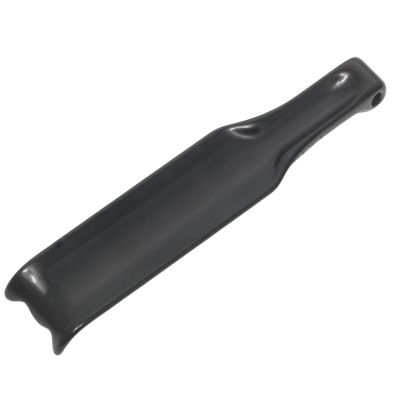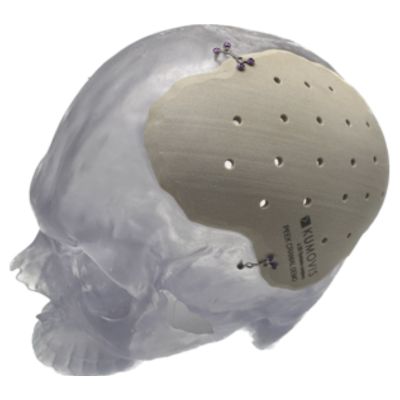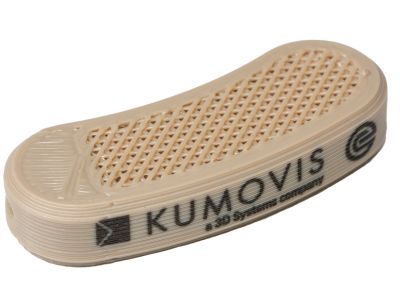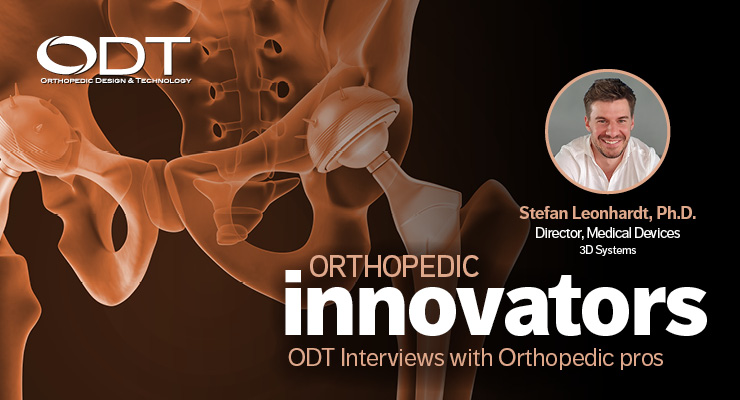Orthopedic implant makers are constantly seeking ways in which they can provide a more natural replacement to native bone. For decades, metal has been the primary material of choice for most of these technologies. Metal does provide certain benefits that make it a good option for orthopedic implants, but there are also challenges that come with it, as well.
Many don’t think of plastic as being a potential replacement for metal when it comes to orthopedic implant materials, but some work quite well. One such material is PEEK, which brings a number of benefits to the implant when fabricated with 3D printing technologies. When compared to metal, it excels in several areas where metal proves to be a challenge.
To help further clarify what benefits can be realized with PEEK instead of metal, Stefan Leonhardt, Ph.D., director of medical devices at 3D Systems, took time to address several questions. He speaks to the use of the material within orthopedics, advantages of using it with a 3D printing process, and how it compares to metal.
Sean Fenske: What makes PEEK unique from other polymers? What benefits does it offer?

This retractor blade is 3D printed in carbon fiber-reinforced PEEK (CFR-PEEK). This material is incredibly durable and resistant to hot steam and other sterilization processes.
Fenske: How does PEEK compare to metal? In what aspects does it perform more favorably than metal?
Dr. Leonhardt: PEEK offers several advantages over metal in medical applications. First, PEEK is known to not cause any allergic reactions, which can be a concern with certain metals. Second, PEEK's mechanical properties—such as high strength, durability and fatigue resistance—are closer to human bone compared to metals, allowing for better load-bearing performance and reducing the risk of stress shielding. Third, PEEK has a thermal expansion coefficient similar to that of bone, which helps minimize the risk of implant loosening due to differential expansion or contraction with temperature changes. Another big differentiator is the radio translucent behavior of PEEK. Metals are radiopaque, which can hinder visibility in medical imaging, making it challenging to assess the surrounding tissues or monitor the implant's performance. This can be particularly relevant in medical applications where regular imaging is necessary, such as in tumor surgery.
Fenske: Where and how is PEEK being used within the orthopedic devices sector?

Patient-specific cranial plates can now be 3D printed in implant-grade PEEK, enabling manufacturers to produce highly durable implants in less time and at lower material costs compared to milling and injection molding.
- Spinal implants—PEEK is commonly used in interbody fusion cages, posterior cervical plates, and pedicle screws for spinal fusion surgeries.
- Trauma implants—PEEK is ideal in trauma implants such as plates and screws for fracture fixation.
- Extremity implants—PEEK is optimal for use in extremity implants, including implants for the hand, foot, and shoulder.
However, most of the PEEK implants are still produced using conventional manufacturing methods like machining, turning, or injection molding.
Fenske: What advantages are gained from fabricating with PEEK through 3D printing rather than another method, like machining?
Dr. Leonhardt: Fabricating PEEK using 3D printing offers several advantages, such as the ability to create complex geometries, design flexibility, efficient material utilization, and reduced post-processing.
With 3D printing, it is possible to generate custom implants tailored to a patient's specific anatomy, based on CT scans or MRI data. This allows for a precise fit and alignment of the implant with the patient's bone, resulting in improved implant stability and function. Patient-specific implants can also reduce the need for extensive intraoperative adjustments and minimize postoperative complications, leading to better patient outcomes.
In addition, 3D printing enables the fabrication of structures with optimized bone ingrowth characteristics. For example, lattice structures or porous scaffolds with controlled pore size, porosity, and interconnectivity can be easily printed using additive manufacturing techniques. These structures can mimic the trabecular bone structure and promote bone ingrowth, facilitating osseointegration and long-term implant stability.
Fenske: What misconceptions do manufacturers and/or end users (i.e., doctors/patients) have about PEEK being used for an implant instead of metal? What is your response to this?
Dr. Leonhardt: Manufacturers and end users may have misconceptions about PEEK's fatigue properties, assuming polymers are inherently weaker or less fatigue-resistant compared to metals. That may be a reason why PEEK has not yet found its way into the market for large joint implants. To overcome these misconceptions, we try to generate data and perform tests to show PEEK implants are highly durable and capable of withstanding the repetitive stresses that occur in orthopedic applications.

This transforaminal lumbar interbody fusion device was 3D printed with VESTAKEEP® Fusion PEEK from Evonik. Enhanced cell attachment and cell proliferation was achieved by adding biphasic calcium phosphate.
Fenske: What’s coming with regard to the use of PEEK for orthopedic implants? Where are the growth opportunities?
Dr. Leonhardt: While PEEK has been predominantly used in load-bearing orthopedic applications such as spinal implants, there are opportunities for its expanded use in other orthopedic applications, such as trauma implants, dental implants, and sports medicine applications. Especially with the advantages of 3D printing, we see huge growth opportunities in these fields.
Another growth segment could be hybrid implants. PEEK can be combined with other materials—such as metals, ceramics, or other polymers—to create hybrid implants with complementary properties. These combinations can result in implants with improved performance, such as enhanced mechanical strength, wear resistance, or imaging visibility, leading to more versatile and customized implant solutions.
Finally, manufacturers are strategizing ways to partner with hospitals as they build out 3D printing labs for manufacturing implants and instruments at the point of care. Hospital-based printing is an area of growth for additive manufacturing, and PEEK is an ideal material for this type of application since it can be printed quickly, is biocompatible, requires minimal post-processing, and can be used for a broad range of both standard and personalized implants.
Fenske: Do you have any additional comments you’d like to share based on any of the topics we discussed or something you’d like to tell orthopedic device manufacturers?
Dr. Leonhardt: PEEK is very well known in the orthopedic market, but we still face misconceptions regarding the ability to 3D print PEEK. Early in its development, printed PEEK constructs often did not show the mechanical properties machined or injection-molded PEEK parts did. 3D Systems’ unique, proprietary technology has addressed these challenges, enabling manufacturers to produce high-strength implants. 3D printing with PEEK is still relatively new so more is needed to educate manufacturers and surgeons about what is now possible, and it is our mission to leverage this great technology to help create better implants and improve patient care.
Click here to find out more about 3D Systems >>>>>














